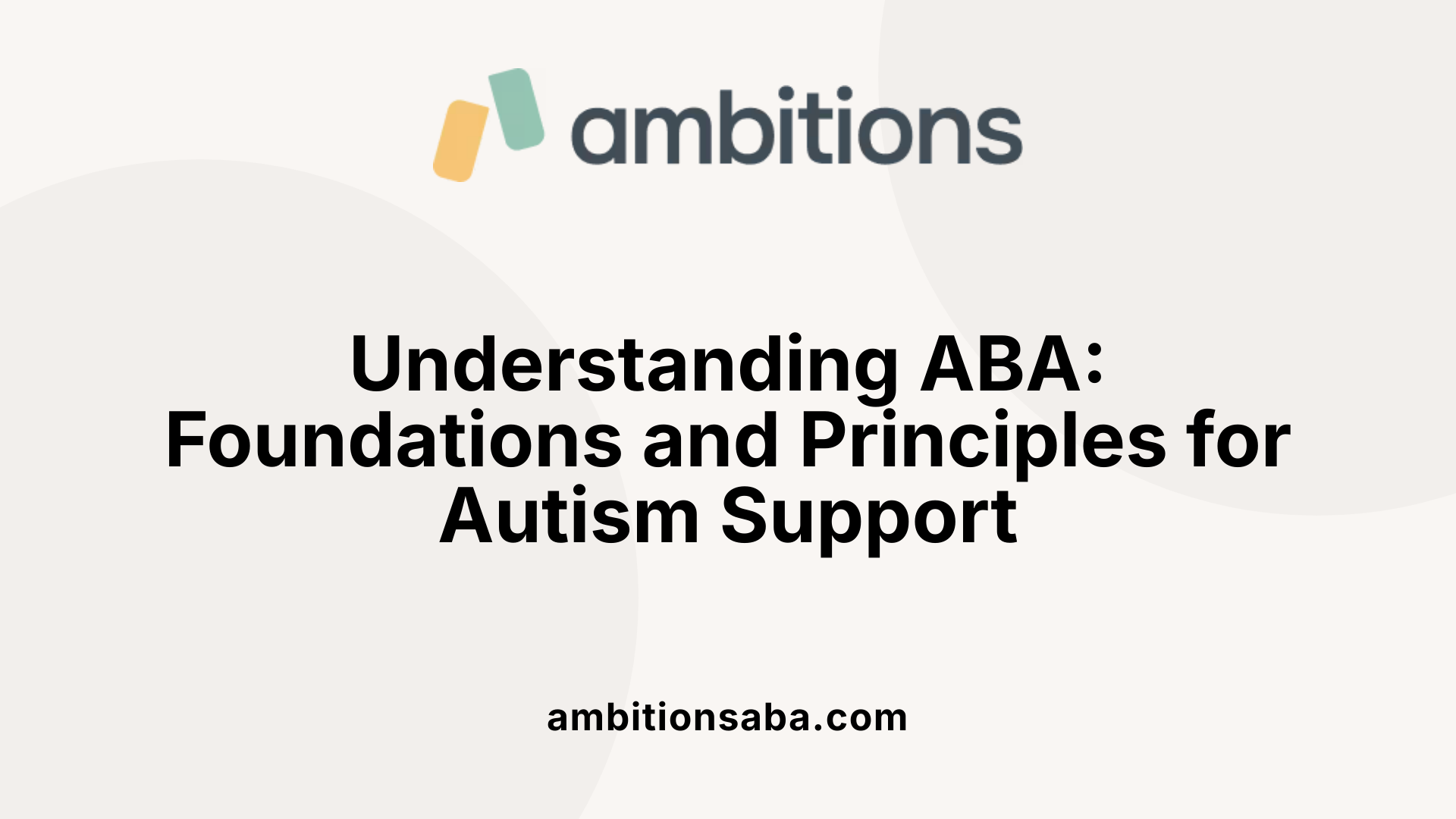Expanding Horizons: ABA Therapy Beyond Childhood
Understanding Progress Assessment in Autism Therapy
Applied Behavior Analysis (ABA) therapy is widely recognized as a powerful intervention for individuals with autism spectrum disorder (ASD). While behavior change is a primary focus, assessing progress in therapy requires a deeper look beyond mere behavior modification. This article explores comprehensive approaches to assess progress in ABA therapy, emphasizing individualized tracking, data analysis, and holistic growth indicators that include communication, social interaction, and adaptive skills.
Foundations of Behavior Analysis Therapy in Autism

What is behavior analysis therapy for autism?
Behavior analysis therapy, widely known as Applied Behavior Analysis (ABA), is a scientific approach focused on understanding and improving behaviors in individuals with autism. It studies how environmental factors influence behavior and uses this insight to encourage positive behaviors and reduce negative ones. ABA therapy breaks down complex behaviors into smaller, manageable parts and applies principles like positive reinforcement — such as praise or rewards — to motivate and teach new skills.
What are key ABA techniques and principles?
ABA incorporates various research-backed techniques including:
- Positive Reinforcement: Encouraging desired behaviors through rewards or praise.
- Modeling: Demonstrating behaviors to teach new skills.
- Discrete Trial Training (DTT): Structured teaching sessions focusing on specific skills.
- Functional Communication Training (FCT): Teaching appropriate communication to replace challenging behaviors.
- Natural Environment Training (NET): Encouraging learning in natural settings.
- Social Skills Training: Using role-playing and social stories to improve interpersonal interactions.
These methods work together to promote communication, social interaction, and daily living skills in children with autism.
How is ABA therapy individualized?
ABA therapy is highly tailored to each child’s unique needs. Continuous assessment tools — such as the Autism Diagnostic Observation Schedule (ADOS-2), ABLLS-R, and VB-MAPP — help behavioral analysts identify strengths and areas requiring support. Using this data, clinicians design personalized intervention plans and regularly modify goals based on ongoing progress. This individualized approach fosters transparency and trust among therapists, clients, and caregivers, ensuring interventions remain effective and relevant as the child develops.
Who Delivers ABA Therapy and Their Role in Progress Assessment

Who Provides Behavior Analysis Therapy for Autism?
Behavior analysis therapy for autism is predominantly delivered by specialized professionals committed to individualized client care. Board Certified Behavior Analysts (BCBAs) lead this effort, holding advanced degrees and certifications. They design and oversee tailored treatment plans rooted in the scientific principles of learning and behavior.
Registered Behavior Technicians (RBTs) support this process by directly implementing the therapy sessions under BCBA supervision. Their training enables them to apply ABA strategies effectively in various environments such as clinics, schools, or homes. Additionally, paraprofessionals or therapy assistants, trained in ABA techniques, may assist in therapy delivery to ensure comprehensive support.
What Are the Assessment Responsibilities of ABA Providers?
A critical responsibility of these providers is ongoing progress assessment. They collect and analyze behavioral data in real time, using behavioral analysis software that streamlines data collection, graphing, and reporting. This enables prompt and informed adjustments to interventions when progress plateaus or obstacles arise.
Through continuous assessment using validated tools and methods, therapists monitor treatment effectiveness, identify trends, and update goals accordingly. Such diligence ensures that interventions remain effective and aligned with client needs.
Why Are Individualized Treatment Plans Important?
Since ABA therapy is highly individualized, the development and continual refinement of personalized treatment plans is essential. These plans address the unique communication, social, and life skills requirements of each child with autism.
By integrating data-driven insights and employing techniques like modeling, positive reinforcement, and communication training, therapists can foster meaningful progress. This individualized approach also establishes trust and transparency among therapists, clients, and caregivers, enhancing therapeutic collaboration and outcomes.
Beyond Behavior: Importance of Comprehensive Progress Tracking in ABA

How Does Progress Tracking Optimize ABA Therapy?
Progress tracking in Applied Behavior Analysis (ABA) is essential for optimizing therapy outcomes. Behavioral analysis software allows therapists to collect data efficiently, generating real-time reports and graphs that highlight client progress. This immediate access to data empowers therapists to promptly adjust interventions if progress stalls or barriers arise, ensuring continuous therapy refinement tailored to each individual's needs.
What Indicators of Progress Extend Beyond Observable Behavior?
While behavior change is a primary focus, progress in ABA therapy encompasses various developmental areas. Tools like Functional Skill Assessments (FSAs) evaluate daily living skills, social skills training targets understanding social cues and role-playing, and communication improvements are achieved through methods such as the Picture Exchange Communication System (PECS) and Functional Communication Training (FCT). Tracking such broad indicators allows for a holistic view of a child's development beyond mere behavior modification.
How Is Data Used to Modify Treatment Plans Effectively?
Comprehensive data collection fosters transparency and collaboration among clinicians, clients, and caregivers. Platforms like CentralReach offer customizable dashboards, automated reporting, and goal-setting features that facilitate team collaboration and data-informed clinical workflows. The ongoing assessment process, combined with scientific tools such as the Autism Diagnostic Observation Schedule (ADOS-2) and Vineland Adaptive Behavior Scales, enables therapists to identify strengths and barriers precisely and adapt interventions accordingly. This dynamic modification of treatment plans ensures that therapy remains personalized and evidence-based, maximizing its effectiveness.
Technological Tools Enhancing Progress Assessment in ABA

What Features Does Behavioral Analysis Software Include?
Behavioral analysis software in ABA therapy offers robust tools designed to streamline how data is collected, analyzed, and reported. Key features often include automated graphing, integrated reporting, customizable dashboards, and goal setting functionalities. These tools simplify data entry tasks such as tracking session notes and provide auto-progression features that allow the software to suggest adjustments in therapy based on client responses.
How Does Real-Time Data Collection and Reporting Improve Therapy?
Real-time data collection and rapid reporting capabilities allow therapists to promptly identify when progress stalls or barriers arise during therapy sessions. This immediacy supports continuous optimization of interventions, ensuring they remain effective and responsive to the individual needs of the client.
How Do Visualization and Collaboration Tools Support Therapy Teams?
Advanced visualization tools help clinicians clearly see client progress and identify both strengths and areas needing support. Collaboration features enable transparent communication and coordinated decision-making among therapists, clients, and caregivers. Platforms like CentralReach provide these functionalities, promoting data-driven discussions that refine therapy goals and enhance overall treatment outcomes.
In summary, behavioral analysis software enriches ABA therapy by providing efficient data management, timely insight into client progress, and collaborative frameworks. This integration supports personalized, dynamic treatment plans essential for successful ABA interventions.
Positive Reinforcement and Skill Acquisition as Markers of Progress

What is the role of positive reinforcement in behavior analysis therapy?
Positive reinforcement is fundamental in behavior analysis therapy, serving to increase the chances that desirable behaviors will recur. When a behavior is followed immediately by a motivating reward—such as praise, a favorite toy, or activity—it encourages ongoing repetition of that behavior. This approach is tailored to each individual’s preferences, ensuring that the reinforcement effectively supports learning and motivation.
How do skill development and functional assessments guide interventions?
Skill acquisition in ABA therapy spans communication, social interaction, and adaptive daily living abilities. Techniques like modeling, Functional Communication Training (FCT), and the Picture Exchange Communication System (PECS) help children develop essential skills. To personalize interventions, functional skill assessments (FSAs) pinpoint specific areas needing support, such as social cues or communication strategies.
These assessments inform targeted interventions that evolve with ongoing data collection and progress tracking. By breaking complex behaviors into manageable parts and reinforcing improvements, therapists create dynamic, evidence-based plans that adapt as the child advances.
This integrated approach, combining positive reinforcement and continuous functional assessment, ensures therapy remains effective, individualized, and transparent for caregivers, therapists, and clients alike.
Critiques and Considerations for Holistic Progress Evaluation

Are there any criticisms or limitations of behavior analysis therapy for autism?
While ABA therapy has demonstrated effectiveness in supporting children with autism spectrum disorder (ASD), it has faced several criticisms and limitations. Some argue that traditional ABA can be too demanding and repetitive, placing heavy focus on conformity rather than embracing individual differences. Earlier ABA practices sometimes relied on aversive techniques and punishment, which have been linked to emotional distress and trauma in clients.
A notable concern among critics is that ABA may encourage masking of natural autistic traits by pushing children to suppress neurodiverse behaviors to meet societal norms. This pressure can impact mental health and hinder authentic self-expression. Moreover, the emphasis on reducing challenging behaviors might inadvertently overlook the autistic individual's autonomy and well-being.
Why is individualized and sensitive approaches important in ABA therapy?
Given these concerns, it is essential to apply ABA therapy flexibly and person-centeredly, respecting each individual's unique needs and identity. Modern ABA practices focus on continuous assessment and data-driven modifications to ensure interventions align with the client's progress and personal goals. This tailored approach fosters trust and transparency among therapists, clients, and caregivers.
How can therapy balance behavior change with respect for autistic identity?
Balancing skill acquisition and behavioral goals with respect for autistic identity requires sensitivity and open collaboration. Successful ABA programs emphasize positive reinforcement, choice, and involvement of clients and families in goal setting. They aim to enhance communication, social skills, and independence without enforcing rigid conformity.
Ultimately, addressing these critiques involves evolving ABA practices toward compassionate, evidence-based methods that uphold the dignity and individuality of people with autism.
Toward a Fuller Understanding of Progress in ABA Therapy
Assessing progress beyond observable behavior in ABA therapy requires multifaceted strategies incorporating individualized assessment, meaningful data collection, and a focus on holistic developmental outcomes. With advancements in behavioral analysis technologies and continued commitment to personalized, respectful approaches, progress can be understood in a richer context that values communication, social skills, adaptive functioning, and overall well-being. Embracing these broader metrics ensures that therapy not only aims for behavioral improvements but also supports each individual's journey toward greater autonomy and quality of life.
References
- ABA Progress Tracking, Data Analysis & Behavioral ...
- The Power of Progress: Applied Behavior Analysis (ABA) ...
- Our Approach
- Applied Behavior Analysis (ABA)
- Applied Behavior Analysis (ABA)
- The Controversy Around ABA
- Applied Behavior Analysis in Children and Youth with ...
- The Controversy Around ABA
- Concerns About ABA-Based Intervention: An Evaluation ...
- Is ABA therapy harmful? The controversy explained

